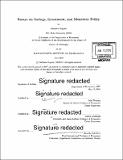| dc.contributor.advisor | Iván Werning and Daron Acemoglu. | en_US |
| dc.contributor.author | Rognlie, Matthew (Matthew James) | en_US |
| dc.contributor.other | Massachusetts Institute of Technology. Department of Economics. | en_US |
| dc.date.accessioned | 2016-09-30T19:32:01Z | |
| dc.date.available | 2016-09-30T19:32:01Z | |
| dc.date.copyright | 2016 | en_US |
| dc.date.issued | 2016 | en_US |
| dc.identifier.uri | http://hdl.handle.net/1721.1/104493 | |
| dc.description | Thesis: Ph. D., Massachusetts Institute of Technology, Department of Economics, 2016. | en_US |
| dc.description | Cataloged from PDF version of thesis. | en_US |
| dc.description | Includes bibliographical references. | en_US |
| dc.description.abstract | This thesis consists of three chapters on savings, investment, and monetary policy. The first chapter studies optimal monetary policy in an environment where negative nominal interest rates are possible, as demonstrated by recent central bank actions worldwide. I identify the central tradeoff: negative rates help stabilize aggregate demand, but at the cost of an inefficient subsidy to paper currency. Near 0%, the first side of this tradeoff dominates, and negative rates are generically optimal whenever output averages below its efficient level. In a benchmark scenario, negative rates are sufficient to undo most welfare losses relative to the first best. Credible commitment by the central bank is essential to implementing optimal policy, which backloads the most negative rates. The option to set negative nominal rates lowers the optimal long-run inflation target, and abolishing paper currency is only optimal when currency demand is highly elastic. The second chapter documents and interprets new facts about the functional distribution of income. It shows that the net capital share of income initially fell in the postwar era, before rising from the 1970s onward, with the entire net increase coming from the housing sector. Accounts of the capital share that emphasize capital accumulation are not consistent with the data: they require empirically improbable elasticities of substitution, and they presume a correlation between the capital-income ratio and capital share that is not visible in the data. A more limited narrative that stresses scarcity and the increased cost of housing better fits the data, as I clarify using a new multisector model of factor shares. The third chapter, joint with Adrien Auclert, studies the possibility that feedbacks between sovereign bond spreads and governments' desire to default may lead to multiple equilibria in sovereign debt markets. We show that such multiplicity does not exist in the infinite-horizon model of Eaton and Gersovitz (1981), a widely adopted benchmark for quantitative analyses of these markets. Our proof may be important to understand Euro government bond markets, and calls for renewed attention on the theoretical conditions that are needed for sovereign debt models to generate multiple equilibria. | en_US |
| dc.description.statementofresponsibility | by Matthew Rognlie. | en_US |
| dc.format.extent | 186 pages | en_US |
| dc.language.iso | eng | en_US |
| dc.publisher | Massachusetts Institute of Technology | en_US |
| dc.rights | M.I.T. theses are protected by copyright. They may be viewed from this source for any purpose, but reproduction or distribution in any format is prohibited without written permission. See provided URL for inquiries about permission. | en_US |
| dc.rights.uri | http://dspace.mit.edu/handle/1721.1/7582 | en_US |
| dc.subject | Economics. | en_US |
| dc.title | Essays on savings, investment, and monetary policy | en_US |
| dc.type | Thesis | en_US |
| dc.description.degree | Ph. D. | en_US |
| dc.contributor.department | Massachusetts Institute of Technology. Department of Economics | |
| dc.identifier.oclc | 958147243 | en_US |
